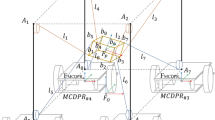Abstract
This paper focuses on the tension reduction method for a Modular Cable-Driven Robotic Arm (MCDRA) that consists of a number of 2-degree-of-freedom (2-DOF) cable-driven joint modules. The MCDRA has implemented a cable routing scheme in which every two adjacent modules co-share one driving cable in order to reduce the number of cables to the minimum required. To investigate the tension distribution of the cables, a new tension analysis algorithm is proposed, in which the cable tension is decomposed into the load-carrying tension and the internal tension. It is revealed that the MCDRA with alternatively co-shared driving cables has inevitable internal tensions, which results in tension magnification. To reduce the cable tensions, the MCDRA is modified by adding two revolute joints with one connected to the base and the other one placed at its distal end. By rotating the base-mounted revolute joint and controlling each of the joints as well as the revolute joint on the distal end accordingly, the modified MCDRA can rotate like a universal joint chain and keep the end-effector pose unchanged. A global optimization algorithm based on interval analysis is proposed to find the optimal rotation angle of the base-mounted revolute joint that produces the lowest cable tensions. The effectiveness of the cable tension reduction method is validated through both simulation and experimental studies.













Similar content being viewed by others
References
Case JC, White EL, Sunspiral V, Kramer-Bottiglio R (2018) Reducing actuator requirements in continuum robots through optimized cable routing. Soft Robotics 5(1):109
Ceccarelli M, Lim W, Yang G, Yeo S, Mustafa S (2012) Modular cable-driven robotic arms for intrinsically safe manipulation. In: Service robots and robotics, pp 274–294 (2012). https://doi.org/10.4018/978-1-4666-0291-5.ch015
Gosselin C, Grenier M (2011) On the determination of the force distribution inoverconstrained cable-driven parallel mechanisms. Meccanica 46(1):3–15
Gouttefarde M, Lamaury J, Reichert C, Bruckmann T (2015) A versatile tension distribution algorithm for \(n\)-dof parallel robots driven by \(n+2\) cables. IEEE Trans Robotics 31(6):1444–1457. https://doi.org/10.1109/TRO.2015.2495005
Lau D, Oetomo D (2016) Conditions on the cable-routing matrix for wrench closure of multilink cable-driven manipulators. J Mech Des 75(7):1000–6
Lau D, Oetomo D, Halgamuge SK (2013) Generalized modeling of multilink cable-driven manipulators with arbitrary routing using the cable-routing matrix. IEEE Trans Robotics 29(5):1102–1113
Liu P, Qiu Y, Su Y, Chang J (2014) On the minimum cable tensions for the cable-based parallel robots. J Appl Math 2014:1–8
Moore RE (1966) Interval analysis. Prentice-Hall, Englewood Cliffs
Moore RE, Kearfott RB, Cloud MJ (2009) Introduction to interval analysis. Society for Industrial and Applied Mathematics, USA
Mustafa SK, Agrawal SK (2011) Reciprocal screw-based force-closure of an n-dof open chain: minimum number of cables required to fully constrain it. In: IEEE international conference on robotics and automation, pp 3029–3034 (2011)
Mustafa SK, Agrawal SK (2012) On the force-closure analysis of n-dof cable-driven open chains based on reciprocal screw theory. IEEE Trans Robotics 28(1):22–31
Mustafa SK, Lim WB, Yang G, Yeo SH, Lin W, Agrawal SK (2013) Cable-driven robots. Springer, London, pp 1–52. https://doi.org/10.1007/978-1-4471-4976-7_101-1
Rezazadeh S, Behzadipour S (2011) Workspace analysis of multibody cable-driven mechanisms. J Mech Robotics 3(2):021005
Wang Y, Yang G, Zheng T, Yang K, Lau, D (2018) Force-closure workspace analysis for modular cable-driven manipulators with co-shared driving cables. In: 2018 13th IEEE conference on industrial electronics and applications (ICIEA), pp 1504–1509. https://doi.org/10.1109/ICIEA.2018.8397947
Wang Y, Song C, Zheng T, Lau D, Yang K, Yang G (2019) Cable routing design and performance evaluation for multi-link cable-driven robots with minimal number of actuating cables. IEEE Access 7:135790–135800. https://doi.org/10.1109/ACCESS.2019.2924982
Xue F, Fan Y, Fan Z (2020) Design and kinematics analysis for a cable-driven underwater snake arm robot. J Phys Conf Ser 1654(1):012028 (6 pp)
Yang G, Lin W, Mustafa S, Pham B, Yeo S (2005) Kinematic design of a 7-dof cable-driven humanoid arm: a solution-in-nature approach. In: IEEE/ASME international conference on advanced intelligent mechatronics, pp 444–449. https://doi.org/10.1109/AIM.2005.1501031
Funding
This paper is funded by the NSFC-Zhejiang Joint Grant (Grant Number U1909215), NSFC grant (Grant Number 92048201), and the Ningbo Key Project of Science and Technology Innovation 2025 (Grant Number 2018B10058, 2018B10068 and 2018B10069).
Author information
Authors and Affiliations
Corresponding author
Ethics declarations
Conflict of interest
The authors declare that they have no conflict of interest.
Ethical approval
This article does not contain any studies with human participants or animals performed by any of the authors.
Additional information
Publisher's Note
Springer Nature remains neutral with regard to jurisdictional claims in published maps and institutional affiliations.
Rights and permissions
About this article
Cite this article
Wang, Y., Yang, G., Zheng, T. et al. Tension reduction method for a modular cable-driven robotic arm with co-shared cables. Intel Serv Robotics 15, 27–38 (2022). https://doi.org/10.1007/s11370-021-00399-y
Received:
Accepted:
Published:
Issue Date:
DOI: https://doi.org/10.1007/s11370-021-00399-y




